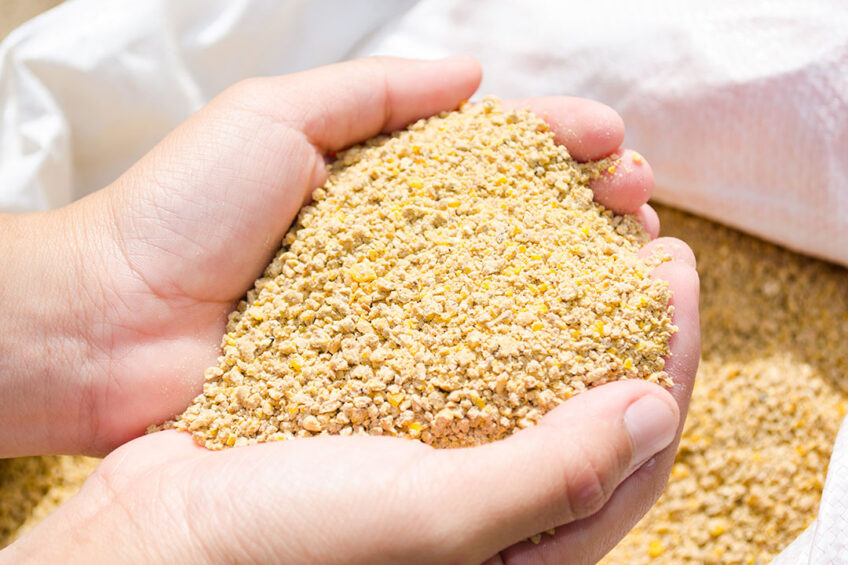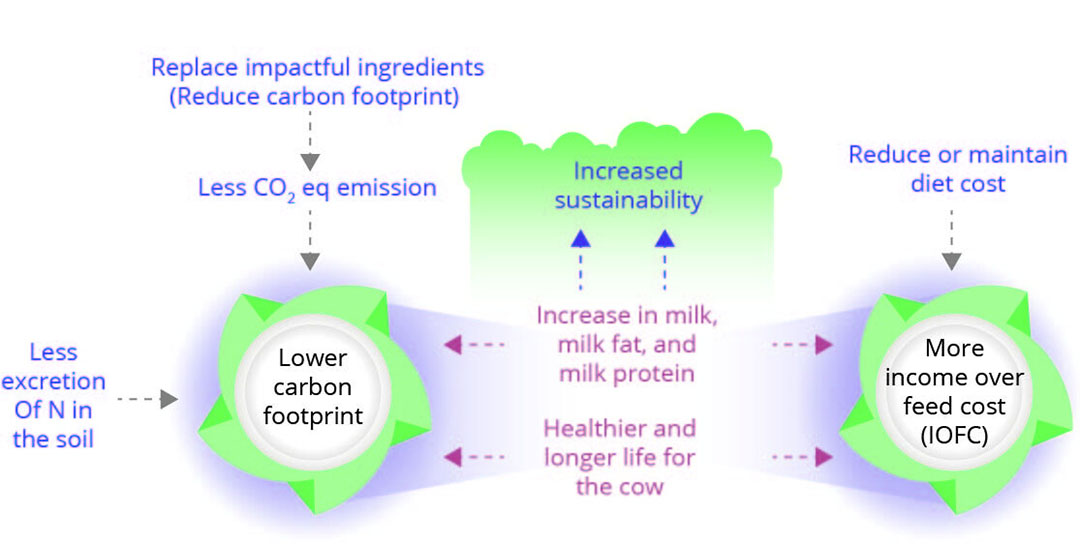Feed additives: A practical example of improved sustainability

The world’s population will reach 10 billion people by 2050 and natural resources are limited: therefore, enhancing the sustainability of animal production is necessary, especially the increase of feed efficiency is critical to minimise losses and produce more with less.
Adisseo provides micro-ingredients for animal nutrition, aimed at improving feed efficiency and feed quality. They include amino acids (AA), enzymes, and vitamins that can be utilised for chicken, swine, ruminant, and dairy farming. These solutions help to increase the profitability, reduce greenhouse gases by reducing energy resource consumption, by limiting organic waste from livestock farming and by optimising the diet with less impactful raw materials. Adisseo analysed how these products could improve sustainability – economic and environmental impact – in animal production by comparing 2 life cycle assessments (LCAs), in poultry and in dairy cows.Monogastric nutrition
Monogastric nutrition
In monogastric nutrition, Adisseo is proposing solutions based on a “Feedase” approach. It addresses the whole indigestible vegetable fraction of feed and improves the overall feed digestibility, including metabolisable energy, digestible AA, available phosphorus, calcium, and sodium. This is the first solution that combine the effects of 2 enzymes frequently employed independently in the production of poultry:
Phytases, which significantly increase the digestibility of minerals;
Non-Starch Polysaccharide Enzymes, which enhance the digestion of nutrients in plant-based feeds allowing the extraction of maximum value from plant-based feedstuffs and reduces the need for animal-based feedstuffs.
A LCA was performed to assess the difference in the environmental impact of poultry production since it allows to increase the feed digestibility.
The study, performed in Colombia with a poultry farmer partner aims to estimate, starting from the feed composition, the impact of 3 different diets:
The first one (Sc1) containing typical enzyme and an appropriate feed mix, including animal by-products (ABP);
The second one (Sc2) optimise with Adisseo enzymes following the Feedase approach (without ABP);
The third one (Sc3) optimise with Adisseo enzymes following the Feedase approach (with ABP, maximum 2.5%).
The results shown that diet optimisation with the Adisseo enzyme mix, with less expensive raw materials, can reduce the feed cost without impacting performances thanks to the improved feed digestibility. Furthermore, the optimisation with less impactful ingredients permitted a significant reduction of the carbon footprint of the two optimised diets, from -14% to -28% CO2 eq/kg meat, compared with control one.
Methionine increases longevity
In ruminants, particularly in dairy production, it has become critical to increase feed efficiency to reduce both the cost of the diet and the excretion in the environment. In fact, ruminants only convert part of the nitrogen they ingest, on average 25%, up to a maximum of 45% into milk protein. The remaining part is excreted through the faeces and urine into the environment, causing environmental problems such as acidification and eutrophication. Today, it is important to improve nitrogen use efficiency. In fact, several on-farm modifications, such us AA balancing can help in this. In this regards, scientific literature shows that methionine usually is the first limiting essential AA for dairy cows and its lack causes suboptimal milk production, an increased likelihood of metabolic disorders, and poor reproductive performance. So, it is recommended today to balance not for protein requirement but for AA requirement. One of the solutions offered is Smartamine M, a coated methionine with a specific pH-sensitive polymer that protects the AA during its passage through the rumen, ensuring its release in the abomasum and absorption in the small intestine. At least 2 different aspects of sustainability are improved by AA-balanced diets. First, feedstuffs with high carbon footprints can be substituted. Second, increasing the efficiency of nitrogen use, it is possible to decrease nitrogen emissions into the environment. Additionally, supplying the methionine needed by cows increases longevity and health. Furthermore, income over feed cost (IOFC), which is beyond sustainability, will be increased or maintained. Balancing rations based on AA contributes both to farm income and sustainability.
Figure 1 – Overview of ruminant trial results.

Experimental trial
A recent demonstration of the efficiency of this approach was carried out in Brittany, France as part of the SOS Protein Program. This experimental trial investigated how to increase the efficiency of metabolisable protein. To do that, the N load was reduced by lowering soybean meal in the diet and balancing the amino acid profile in lactating dairy cow rations. Starting from this in vivo trial and from a prediction model based on a meta-analysis done with AgroParisTech and INRA, a cradle-to-farm-gate LCA was performed considering the potential effect of methionine on milk quality, milk yield, animal health, and reproduction. The main effect is an increase of 1.3% in milk production, with improved milk quality (3.6% in protein and 0.5% in fat content). Consequently, IOFC increased by 9.7% with the diet optimisation (Figure 1).
AA balancing is beneficial not only from an economical point of view, but also because it enables to use fewer high-impact raw materials and leads to less nitrogen loss into the environment. The result is a diet more efficient and with a lower carbon footprint (from -14% to -49% of CO2 eq per kg of FPCM).
Aiding in sustainable animal production
Sustainability is a priority for Adisseo and the main goal is to help farmers to produce more with less. To do that it is necessary to increase the feed efficiency through diet optimisation. The use of feed additives, which help to increase feed digestibility, or AA balancing with the aim of reducing the N load in the diet, can be essential to improve the efficiency. These two LCAs showed that feed additives and diet optimisation can help the farmer not only to increase the profitability but also to decrease the environmental impact and to contribute to more sustainable animal productions.







